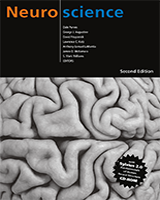By agreement with the publisher, this book is accessible by the search feature, but cannot be browsed.
NCBI Bookshelf. A service of the National Library of Medicine, National Institutes of Health.
Purves D, Augustine GJ, Fitzpatrick D, et al., editors. Neuroscience. 2nd edition. Sunderland (MA): Sinauer Associates; 2001.

Neuroscience. 2nd edition.
Show detailsThe visceral motor system clearly requires sensory feedback to control and modulate its many functions. As in the case of somatic sensory modalities (see Chapters 9 and 10), the cell bodies of the visceral afferent fibers lie in the dorsal root ganglia or the sensory ganglia associated with cranial nerves (in this case, the vagus, glossopharyngeal, and facial nerves) (Figure 21.5A). The neurons in the dorsal root ganglia send an axon peripherally to end in sensory receptor specializations, and an axon centrally to terminate in a part of the dorsal horn of the spinal cord near the lateral horn, where the preganglionic neurons of both sympathetic and parasympathetic divisions are located. In addition to making local reflex connections, branches of these visceral sensory neurons also travel rostrally to innervate nerve cells in the brainstem; in this case, however, the target is the nucleus of the solitary tract in the upper medulla (Figure 21.5B). The afferents from viscera in the head and neck that enter the brainstem via the cranial nerves also terminate in the nucleus of the solitary tract (see Figure 21.5B). This nucleus, as described in the next section, integrates a wide range of visceral sensory information and transmits to the hypothalamus and to the relevant motor nuclei in the brainstem tegmentum.

Figure 21.5
Organization of sensory input to the visceral motor system. (A) Afferent input from the cranial nerves relevant to visceral sensation (as well as afferent input ascending from the spinal cord not shown here) converge on the nucleus of the solitary tract. (more...)
Sensory fibers related to the viscera convey only limited information to consciousness—primarily pain. Nonetheless, the visceral afferent information of which we are not aware is essential for the functioning of autonomic reflexes. Specific examples described in more detail later in the chapter include afferent information relevant to cardiovascular control, to the control of the bladder, and to the governance of sexual functions (although sexual reflexes are, exceptionally, not mediated by the nucleus of the solitary tract).
- Sensory Components of the Visceral Motor System - NeuroscienceSensory Components of the Visceral Motor System - Neuroscience
- Selective Serotonin Reuptake InhibitorsSelective Serotonin Reuptake InhibitorsCompounds that specifically inhibit the reuptake of serotonin in the brain.<br/>Year introduced: 2023(1993)MeSH
- ZNF143 zinc finger protein 143 [Bos taurus]ZNF143 zinc finger protein 143 [Bos taurus]Gene ID:533243Gene
Your browsing activity is empty.
Activity recording is turned off.
See more...